Klemen Kotar
Model Connectomes: A Generational Approach to Data-Efficient Language Models
Apr 29, 2025Abstract:Biological neural networks are shaped both by evolution across generations and by individual learning within an organism's lifetime, whereas standard artificial neural networks undergo a single, large training procedure without inherited constraints. In this preliminary work, we propose a framework that incorporates this crucial generational dimension - an "outer loop" of evolution that shapes the "inner loop" of learning - so that artificial networks better mirror the effects of evolution and individual learning in biological organisms. Focusing on language, we train a model that inherits a "model connectome" from the outer evolution loop before exposing it to a developmental-scale corpus of 100M tokens. Compared with two closely matched control models, we show that the connectome model performs better or on par on natural language processing tasks as well as alignment to human behavior and brain data. These findings suggest that a model connectome serves as an efficient prior for learning in low-data regimes - narrowing the gap between single-generation artificial models and biologically evolved neural networks.
3D Scene Understanding Through Local Random Access Sequence Modeling
Apr 04, 2025Abstract:3D scene understanding from single images is a pivotal problem in computer vision with numerous downstream applications in graphics, augmented reality, and robotics. While diffusion-based modeling approaches have shown promise, they often struggle to maintain object and scene consistency, especially in complex real-world scenarios. To address these limitations, we propose an autoregressive generative approach called Local Random Access Sequence (LRAS) modeling, which uses local patch quantization and randomly ordered sequence generation. By utilizing optical flow as an intermediate representation for 3D scene editing, our experiments demonstrate that LRAS achieves state-of-the-art novel view synthesis and 3D object manipulation capabilities. Furthermore, we show that our framework naturally extends to self-supervised depth estimation through a simple modification of the sequence design. By achieving strong performance on multiple 3D scene understanding tasks, LRAS provides a unified and effective framework for building the next generation of 3D vision models.
Counterfactual World Modeling for Physical Dynamics Understanding
Dec 26, 2023



Abstract:The ability to understand physical dynamics is essential to learning agents acting in the world. This paper presents Counterfactual World Modeling (CWM), a candidate pure vision foundational model for physical dynamics understanding. CWM consists of three basic concepts. First, we propose a simple and powerful temporally-factored masking policy for masked prediction of video data, which encourages the model to learn disentangled representations of scene appearance and dynamics. Second, as a result of the factoring, CWM is capable of generating counterfactual next-frame predictions by manipulating a few patch embeddings to exert meaningful control over scene dynamics. Third, the counterfactual modeling capability enables the design of counterfactual queries to extract vision structures similar to keypoints, optical flows, and segmentations, which are useful for dynamics understanding. We show that zero-shot readouts of these structures extracted by the counterfactual queries attain competitive performance to prior methods on real-world datasets. Finally, we demonstrate that CWM achieves state-of-the-art performance on the challenging Physion benchmark for evaluating physical dynamics understanding.
WhisBERT: Multimodal Text-Audio Language Modeling on 100M Words
Dec 07, 2023

Abstract:Training on multiple modalities of input can augment the capabilities of a language model. Here, we ask whether such a training regime can improve the quality and efficiency of these systems as well. We focus on text--audio and introduce Whisbert, which is inspired by the text--image approach of FLAVA (Singh et al., 2022). In accordance with Babylm guidelines (Warstadt et al., 2023), we pretrain Whisbert on a dataset comprising only 100 million words plus their corresponding speech from the word-aligned version of the People's Speech dataset (Galvez et al., 2021). To assess the impact of multimodality, we compare versions of the model that are trained on text only and on both audio and text simultaneously. We find that while Whisbert is able to perform well on multimodal masked modeling and surpasses the Babylm baselines in most benchmark tasks, it struggles to optimize its complex objective and outperform its text-only Whisbert baseline.
Are These the Same Apple? Comparing Images Based on Object Intrinsics
Nov 01, 2023Abstract:The human visual system can effortlessly recognize an object under different extrinsic factors such as lighting, object poses, and background, yet current computer vision systems often struggle with these variations. An important step to understanding and improving artificial vision systems is to measure image similarity purely based on intrinsic object properties that define object identity. This problem has been studied in the computer vision literature as re-identification, though mostly restricted to specific object categories such as people and cars. We propose to extend it to general object categories, exploring an image similarity metric based on object intrinsics. To benchmark such measurements, we collect the Common paired objects Under differenT Extrinsics (CUTE) dataset of $18,000$ images of $180$ objects under different extrinsic factors such as lighting, poses, and imaging conditions. While existing methods such as LPIPS and CLIP scores do not measure object intrinsics well, we find that combining deep features learned from contrastive self-supervised learning with foreground filtering is a simple yet effective approach to approximating the similarity. We conduct an extensive survey of pre-trained features and foreground extraction methods to arrive at a strong baseline that best measures intrinsic object-centric image similarity among current methods. Finally, we demonstrate that our approach can aid in downstream applications such as acting as an analog for human subjects and improving generalizable re-identification. Please see our project website at https://s-tian.github.io/projects/cute/ for visualizations of the data and demos of our metric.
Unifying (Machine) Vision via Counterfactual World Modeling
Jun 02, 2023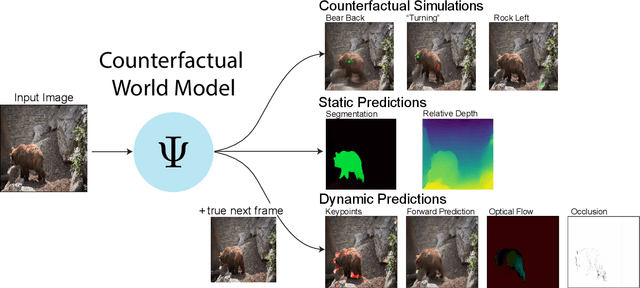
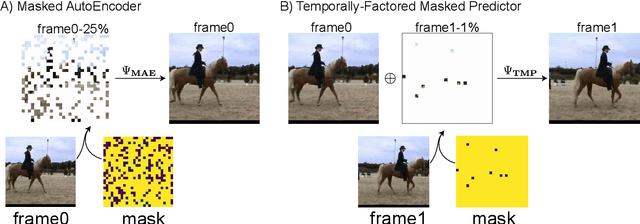
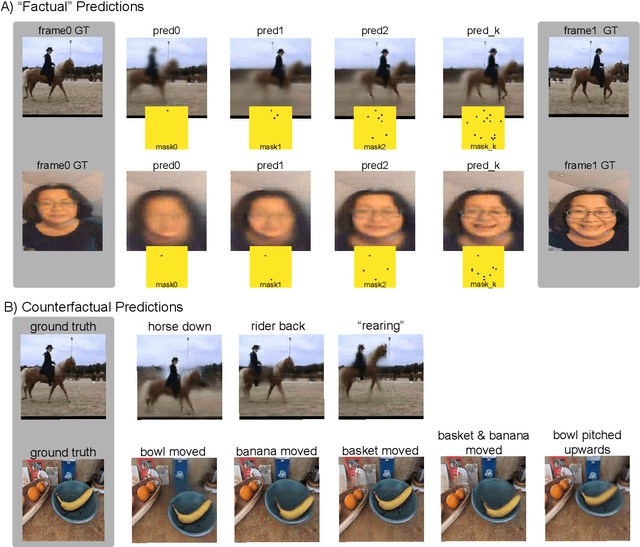
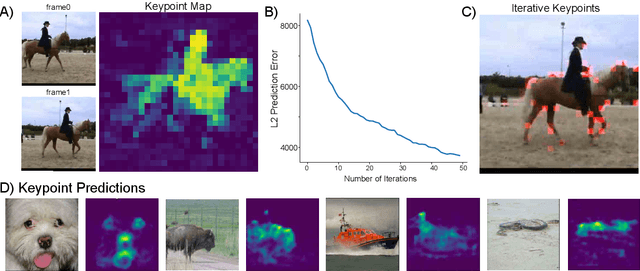
Abstract:Leading approaches in machine vision employ different architectures for different tasks, trained on costly task-specific labeled datasets. This complexity has held back progress in areas, such as robotics, where robust task-general perception remains a bottleneck. In contrast, "foundation models" of natural language have shown how large pre-trained neural networks can provide zero-shot solutions to a broad spectrum of apparently distinct tasks. Here we introduce Counterfactual World Modeling (CWM), a framework for constructing a visual foundation model: a unified, unsupervised network that can be prompted to perform a wide variety of visual computations. CWM has two key components, which resolve the core issues that have hindered application of the foundation model concept to vision. The first is structured masking, a generalization of masked prediction methods that encourages a prediction model to capture the low-dimensional structure in visual data. The model thereby factors the key physical components of a scene and exposes an interface to them via small sets of visual tokens. This in turn enables CWM's second main idea -- counterfactual prompting -- the observation that many apparently distinct visual representations can be computed, in a zero-shot manner, by comparing the prediction model's output on real inputs versus slightly modified ("counterfactual") inputs. We show that CWM generates high-quality readouts on real-world images and videos for a diversity of tasks, including estimation of keypoints, optical flow, occlusions, object segments, and relative depth. Taken together, our results show that CWM is a promising path to unifying the manifold strands of machine vision in a conceptually simple foundation.
ENTL: Embodied Navigation Trajectory Learner
Apr 07, 2023



Abstract:We propose Embodied Navigation Trajectory Learner (ENTL), a method for extracting long sequence representations for embodied navigation. Our approach unifies world modeling, localization and imitation learning into a single sequence prediction task. We train our model using vector-quantized predictions of future states conditioned on current states and actions. ENTL's generic architecture enables sharing of the spatio-temporal sequence encoder for multiple challenging embodied tasks. We achieve competitive performance on navigation tasks using significantly less data than strong baselines while performing auxiliary tasks such as localization and future frame prediction (a proxy for world modeling). A key property of our approach is that the model is pre-trained without any explicit reward signal, which makes the resulting model generalizable to multiple tasks and environments.
Break and Make: Interactive Structural Understanding Using LEGO Bricks
Jul 27, 2022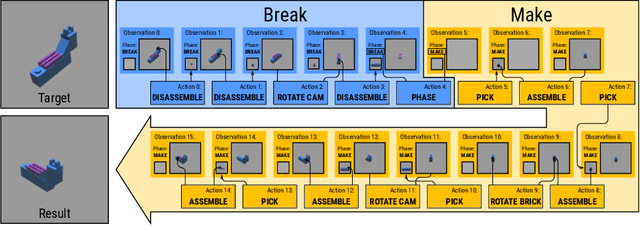
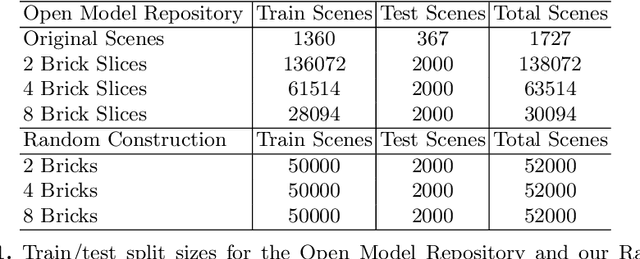
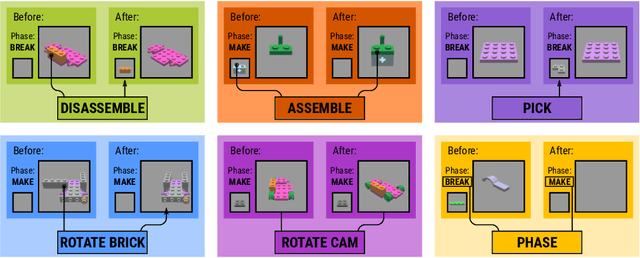

Abstract:Visual understanding of geometric structures with complex spatial relationships is a fundamental component of human intelligence. As children, we learn how to reason about structure not only from observation, but also by interacting with the world around us -- by taking things apart and putting them back together again. The ability to reason about structure and compositionality allows us to not only build things, but also understand and reverse-engineer complex systems. In order to advance research in interactive reasoning for part-based geometric understanding, we propose a challenging new assembly problem using LEGO bricks that we call Break and Make. In this problem an agent is given a LEGO model and attempts to understand its structure by interactively inspecting and disassembling it. After this inspection period, the agent must then prove its understanding by rebuilding the model from scratch using low-level action primitives. In order to facilitate research on this problem we have built LTRON, a fully interactive 3D simulator that allows learning agents to assemble, disassemble and manipulate LEGO models. We pair this simulator with a new dataset of fan-made LEGO creations that have been uploaded to the internet in order to provide complex scenes containing over a thousand unique brick shapes. We take a first step towards solving this problem using sequence-to-sequence models that provide guidance for how to make progress on this challenging problem. Our simulator and data are available at github.com/aaronwalsman/ltron. Additional training code and PyTorch examples are available at github.com/aaronwalsman/ltron-torch-eccv22.
Interactron: Embodied Adaptive Object Detection
Feb 01, 2022



Abstract:Over the years various methods have been proposed for the problem of object detection. Recently, we have witnessed great strides in this domain owing to the emergence of powerful deep neural networks. However, there are typically two main assumptions common among these approaches. First, the model is trained on a fixed training set and is evaluated on a pre-recorded test set. Second, the model is kept frozen after the training phase, so no further updates are performed after the training is finished. These two assumptions limit the applicability of these methods to real-world settings. In this paper, we propose Interactron, a method for adaptive object detection in an interactive setting, where the goal is to perform object detection in images observed by an embodied agent navigating in different environments. Our idea is to continue training during inference and adapt the model at test time without any explicit supervision via interacting with the environment. Our adaptive object detection model provides a 11.8 point improvement in AP (and 19.1 points in AP50) over DETR, a recent, high-performance object detector. Moreover, we show that our object detection model adapts to environments with completely different appearance characteristics, and its performance is on par with a model trained with full supervision for those environments.
Contrasting Contrastive Self-Supervised Representation Learning Models
Mar 25, 2021



Abstract:In the past few years, we have witnessed remarkable breakthroughs in self-supervised representation learning. Despite the success and adoption of representations learned through this paradigm, much is yet to be understood about how different training methods and datasets influence performance on downstream tasks. In this paper, we analyze contrastive approaches as one of the most successful and popular variants of self-supervised representation learning. We perform this analysis from the perspective of the training algorithms, pre-training datasets and end tasks. We examine over 700 training experiments including 30 encoders, 4 pre-training datasets and 20 diverse downstream tasks. Our experiments address various questions regarding the performance of self-supervised models compared to their supervised counterparts, current benchmarks used for evaluation, and the effect of the pre-training data on end task performance. We hope the insights and empirical evidence provided by this work will help future research in learning better visual representations.
 Add to Chrome
Add to Chrome Add to Firefox
Add to Firefox Add to Edge
Add to Edge